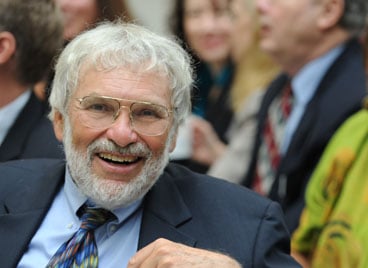Press Release
For media inquiries, contact Brian Sheppard at [email protected] or 973-642-8583. Press Releases available here.
Getting Julius to Talk: The Tragic Execution of Ethel Rosenberg
Seton Hall Law School report uncovers new evidence of ‘no evidence’
A three year, detailed investigation by the Seton Hall University School of Law Center for Policy and Research uncovers new evidence and finds that the prosecution of Ethel Rosenberg served merely as leverage to compel Julius Rosenberg to talk and continued to its lethal conclusion when Julius called the government’s bluff and remained silent.
NEWARK, NJ – December 21, 2016 – The U.S. Government arrested and indicted Ethel Rosenberg in order to obtain leverage against her husband Julius. Her subsequent trial and execution were merely the tragic result of a prosecution determined to follow through with a failed gambit designed to pressure Julius Rosenberg into implicating others. So says the report released today by Seton Hall Law School Professor, Mark Denbeaux, director of the Center for Policy & Research.
The Seton Hall Law Center for Policy and Research discovered a July 1950 FBI memorandum that reports that the government realized it did not have enough evidence to arrest Ethel Rosenberg, but that she could be used as "leverage" to pressure Julius into confessing and implicating others. In January 1951, the US Attorney informed a Congressional Committee that Julius was a tough nut to crack and that the Prosecutor needed to severely threaten Ethel in order to make Julius cooperate. The prosecution seemed confident that the threat of severe punishment for his wife would produce that cooperation. The optimism was unfounded: Julius refused to talk, and the prosecution, having started down this road, promptly developed “evidence,” in the form of continually evolving witness statements, that ultimately led to Ethel’s execution.
After a painstaking investigation into the evidence against Ethel Rosenberg, the Seton Hall Law Center for Policy and Research concluded that the U.S. government’s case against Ethel was basically nonexistent at the outset; even at trial, the continually shifting stories, reflected in the evolution of core witness statements, seriously undermine the credibility of the conviction.
The research report compiled by the Seton Hall Law Center for Policy and Research analyzes all of the evidence and the statements of the two witnesses against Ethel, as well as the contemporaneous assessments of the FBI and the Department of Justice to discern the U.S. government’s basis for seeking the death penalty against her. The report is available for review by visiting http://law.shu.edu/ethelrosenberg.
Highlights from the report are:
* The government’s prosecution of Ethel relied exclusively on the testimony of her brother and sister-in-law, David and Ruth Greenglass, both designated as co-conspirators.
* David Greenglass, who worked in Los Alamos, stole the classified designs for the atomic bomb and passed them through his wife, Ruth Greenglass, who gave them to Julius, who the government asserted, gave them to the KGB.
* In return for their cooperation, David Greenglass was sentenced to only fifteen years in prison, while Ruth Greenglass was never charged with any crime, allowing her to continue to care for their children
*The Seton Hall Law Center for Policy and Research uncovered a July 17, 1950 internal FBI memo that determined there was “insufficient evidence” to arrest Ethel Rosenberg, but she could be used as “a lever against her husband;” additional contemporaneous documents from the FBI and DOJ repeatedly note the absence of evidence implicating Ethel in the conspiracy.
*One day after the July 17, 1950 memo announcing the “insufficient evidence” to arrest Ethel, David Greenglass was given a special visit in jail with his wife and child arranged by the FBI. The very next day, consistent with his agreement to cooperate, David suddenly stated that his wife told him about a conversation she had had with Ethel while he wasn’t present. This statement by David Greenglass was inexplicably considered by the government as “corroboration.”
*David Greenglass’ initial statements do not implicate Ethel; after she and Julius were indicted and Julius refused to cooperate, on the eve of trial both David and Ruth Greenglass provided new “evidence” to implicate Ethel and provide a threadbare basis for her conviction and execution.
*One month prior to trial, an Assistant U.S. Attorney General (AUSA) charged with prosecuting the Rosenberg’s appeared before a Congressional Committee to brief it on the case. The AUSA reported that the Department of Justice “felt” that Julius Rosenberg was “the keystone to a lot of other potential espionage agents” and that “if we can really break him, that he will open the gates and give us information which [would] lead to a lot of other individuals.” To that end, the AUSA informed the Committee that, “we think it is important that he be under the shadow of a death penalty, at least for a while,” and that if they were further able to subject Ethel Rosenberg to a “stiff sentence of 25 or 30 years” Julius might be more inclined to cooperate. The AUSA added that this “is about the only thing you can use as a lever on these people.”
"It is clear that Julius, and David and Ruth Greenglass were guilty of espionage, and that all but Julius grabbed the lever. It is equally clear that the government knew that there was no real evidence of espionage by Ethel, and yet she was sent to the electric chair,” said Professor Denbeaux. “It was a hysterical time, but it’s still hard to accept that our government knowingly executed someone without any real evidence. The execution of Ethel Rosenberg was a classic violation of Kant’s categorical imperative against using people as means, not ends.”
Elizabeth Mancuso, Research Fellow and a co-author of the report said, “When we began, all of us assumed that Ethel could not have been executed with so little evidence. By the end we all realized that her execution (and probably her conviction) was not the result of evidence but because of the prosecution’s failed gamble against Julius. The government’s manipulation of familial relationships to secure a conviction is just as disturbing today as it should have been sixty years ago.”
About Seton Hall University School of Law
Founded in 1951 and located in Newark, Seton Hall University School of Law is New Jersey’s only private law school and a leading Catholic law school in the New York metropolitan area. Seton Hall Law is dedicated to preparing students for the practice of law through excellence in scholarship and teaching, with a strong focus on clinical education. The Law School also offers a robust selection compliance programs for law, graduate students, as well as mid-career professionals in the health, life sciences, and financial services sectors.
###
Contacts:
Janelle LoBello
Director of Communications, Seton Hall Law
Office: 973-642-8583
Cell:
Email: [email protected]
December 356, 2016





